Innistrad: Midnight Hunt Mechanics
No plane in the Multiverse inspires terror amongst its denizens quite like Innistrad. Should you be afraid? Of course not. It's a card game. This setting is amazing. And we're going back with Innistrad: Midnight Hunt! But what new abilities, mechanics, keywords, and such await us? Only one way to find out, and that's to do what we always do on Innistrad: ignore the consequences and charge right into the darkness with no regard for personal safety or preparation whatsoever and why are you thinking let's just go
Day & Night, Daybound & Nightbound
Not everything on Innistrad is as it seems. Yes, transforming double-faced cards are back, largely in the form of Werewolves. In this set, we're introducing two new designations that the game itself can have: day and night. During day, things may be a little more sedate. The fearsome Werewolves free their minds at night. How does it all play out? Let's check out Tavern Ruffian and Tavern Smasher.
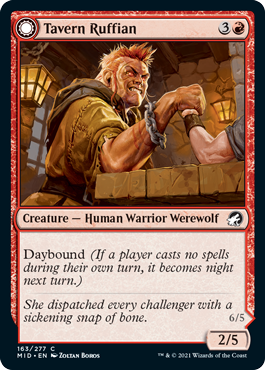
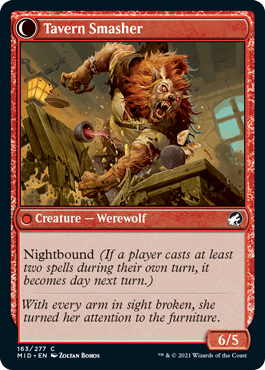
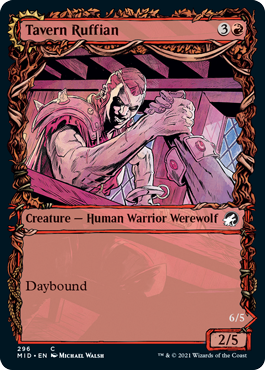
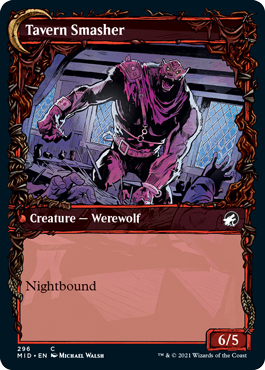
When the game starts, it's neither day nor night. In most games, it will become day first. The most common way that will happen is if a permanent with daybound appears on the battlefield.
A Quick Interlude About Transforming Double-Faced Cards
Transforming double-faced cards like Tavern Smasher // Tavern Ruffian can be cast with their front faces up, and if they are put onto the battlefield without being cast, they are put onto the battlefield front face up.
One easy way to tell if a double-faced card is transforming as opposed to modal (like cards from previous sets, such as Strixhaven: School of Mages) is that each transforming double-faced card will have an ability that either transforms it into their other face or has it enter the battlefield or be cast transformed. The back faces of transforming double-faced cards don't have mana costs because they usually can't be cast transformed, although the new disturb ability provides an exception. That's coming up in a bit.
If you ever need to know the mana value of the back face of a transforming double-faced card, use the mana cost of the front face. For example, the mana value of Tavern Smasher is 4. That's a little strange, we know, but when your opponent tries to cast [autocard]Eliminate[/autocard] (from Core Set 2021) on it and can't, you'll be thankful.
And Now Back to Our Show
In some uncommon cases, it may become night first because a permanent with nightbound appears first. The important thing is that once it's day or night, the game will be exactly one of those designations, day or night, going back and forth until the game ends. It can never return to being neither. And the whole game is either day or night. It's not a per player thing.
If it's day, each double-faced card with daybound and nightbound will enter the battlefield with its daybound face up. If it's night, each of them will enter nightbound face up. Note that this doesn't affect spells on the stack. Even during night, if you cast Tavern Ruffian, it will be Tavern Ruffian on the stack. As the spell resolves, it will simply enter the battlefield as Tavern Smasher.
From Day to Night and Back Again
There are two ways for the game's day/night designation to change. The first should be familiar to those of you who've visited Innistrad before.
If it's day as a turn begins, and the previous turn's active player didn't cast a spell last turn, it becomes night. Similarly, if it's night as a turn begins, if the previous turn's active player cast two or more spells last turn, it becomes day. To help everyone keep track of day and night, many Innistrad: Midnight Hunt booster packs have this helper card that also reminds you of these rules.
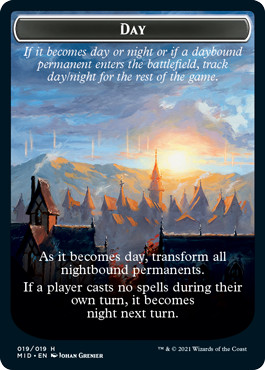
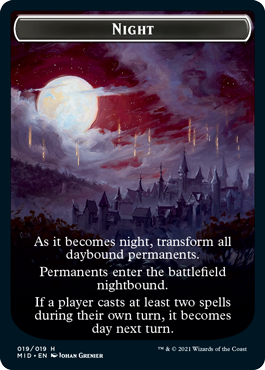
As you can see, the card that helps you understand whether it's day or night is also double faced. UX Designer Daniel Holt points out, "It only made sense that the helper card itself be a double-faced card that you could 'transform' on the battlefield to indicate what day/night designation it was in. Other than that, we wanted beautiful new art to be the main focal point with rules text floating on the image and most frame elements removed."
I don't know about beautiful artwork, but it's worth noting the rules also say another way the day/night designation can change is when some cards have effects that just say it becomes day or night. This can happen at any point in the turn when the effect says so.
Transforming (This Is the Good Part)
As it becomes day, all double-faced cards with nightbound transform to their daybound faces. As it becomes night, all double-faced cards with daybound transform to their nightbound faces. In other words, these double-faced cards should always be in sync, no matter who controls them. What's more, permanents with daybound and nightbound can't transform any other way. Sorry, [autocard]Moonmist[/autocard] fans. The "bound" part of daybound and nightbound is serious.
Disturb
Graveyard mechanic? I'm glad you asked. Disturb also appears on transforming double-faced cards, but these don't transform on the battlefield. Rather, disturb allows you to cast these cards transformed from your graveyard. Death, you see, is only the beginning.
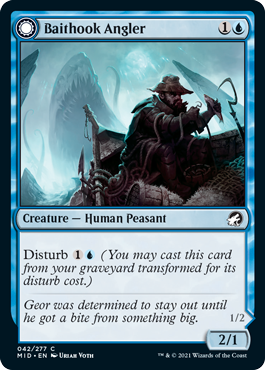
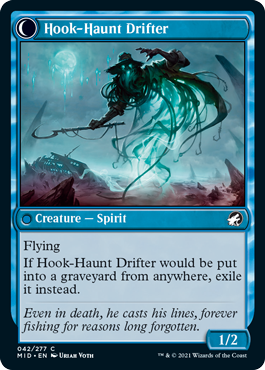
Ah. A fisherman. On Innistrad. Sure to end well.
Once Baithook Angler is in your graveyard, and it doesn't matter how it gets there, you can use the disturb ability to cast its back face. Unlike, well, every other transforming double-faced card we've seen thus far, you're actually casting the back face, so put Hook-Haunt Drifter on the stack. Rather than pay its mana cost, which you'll observe it doesn't have, you pay the disturb cost of {1}{U}.
Like most other creature spells, Hook-Haunt Drifter can be responded to, countered, and the like. If it resolves, it will enter the battlefield as, well, Hook-Haunt Drifter. It won't transform while on the battlefield except in some very unusual circumstances (or as they're called on Innistrad, circumstances).
The back faces of cards with disturb have an ability that exiles them instead if they would be put into a graveyard from anywhere. Effectively, this means from the stack or the battlefield, the two zones where they can be back face up. So, if Hook-Haunt Drifter is countered, to exile it goes. If it would die once on the battlefield, it's exiled instead.
Coven
But what if not every new ability was all about death and terror? What if one of them was about the power of friendship? Or friends with powers? Or something like that?
Coven is an ability word that's used to highlight abilities that get better if you control three or more creatures with different powers. This is where you may have a moment where you think that "powers" means "abilities," but no, "powers" is just the number before the slash opposite toughness. It's cool. We did it, too. For example, a 1/1 creature, a 3/1 creature, and a 4/6 creature have three different powers (specifically, 1, 3, and 4).
Some coven abilities are triggered. Candlelit Cavalry, you're up.
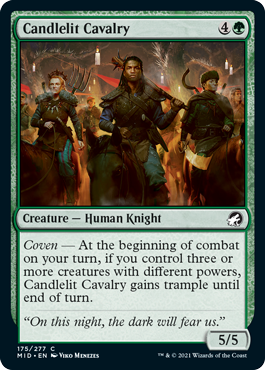
An ability like Candlelit Cavalry's checks your creatures at the time it would trigger to see if your squad qualifies. If it does, the ability triggers and goes on the stack. The ability checks again as it would resolve to see if you still control at least three creatures with different powers. It doesn't have to be the same three creatures. Doesn't have to be the same three powers. Just has to be a coven, as they say. Well, as they say informally. If you have one, the ability resolves.
Some coven abilities are activated. Candletrap, you're up.
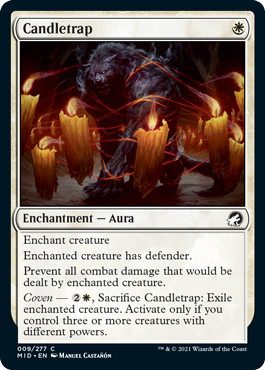
You must control a coven only at the time you activate the ability. Once you legally activate the ability, it doesn't matter what creatures you control or what their powers are as the ability tries to resolve.
Even instants and sorceries get in on the fun. Might of the Old Ways, you're up. We're out of candles apparently.
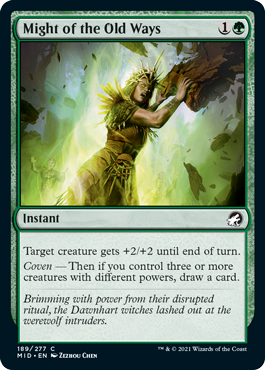
Spells like Might of the Old Ways have an additional effect if you control three or more creatures with different powers as they resolve. Might of the Old Ways in particular is tricky because effects always happen in the order they're written. That +2/+2 bonus might cause you to suddenly lose your coven, denying you the card, or it may cause you to suddenly have one, giving you the card.

